How to intersect a line with a point off the page using a straight edge and compass (see description)
The following solution to the problem uses the ruler only and is based on Desargues's theorem.
Let $R=AB\cap A'B'$ be the point out from the sheet and $P$ a point on the sheet. It's required to draw the line $PR$.
Let $O=AA'\cap BB'$, and choose a line $c\supset O$. Let $C=c\cap AP$ and $C'=c\cap A'P$. The triangles $ABC$ and $A'B'C'$ are homologous since $O=AA'\cap BB'\cap CC'$, thus $R=AB\cap A'B'$, $P=AC\cap A'C'$ and $Q=BC\cap B'C'$ lies on a line. Consequently, $PQ$ is the required line.

On the graph below :
The two given lines are $(L_1)$ and $(L_2)$.
From B, draw a parallel to $(L_1)$. It intersect $(L_2)$ in D.
From B, draw a parallel to $(L_2)$. It intersect $(L_1)$ in C.
With straight edge and compass, draw the centre M of the segment CD.
Draw the line BM.
The point A is on this line, but outside the page.

$$ $$ METHOD WITH HOMOTHETY :
Chose an arbitrary homothetic ratio $1/n$ with $n$ large enough so that the figure becomes sufficiently small to be entirely on the page.
For example, on the next drawing, $n=3$.
$(L_1)$ and $(L_2)$ are the two given straight lines which the intersection point A is outside the page.
With center of homothety $H$, draw the homothetic line of $(L_1)$, that is :
Take an arbitrary point P on $(L_1)$ and divide HP in $n$ equal parts.
The method to divide a segment in equal parts is well known. Just to remind it, the accessory construction in yellow on the figure : Draw $n$ aligned equal segments of arbitrary length
Hh$_1=$h$_1$h$_2$=...=h$_{n-1}$h$_n$. From h$_1$ , h$_2$ , ... , h$_{n-1}$ draw the parallels to h$_n$P. They intersect HP in p$_1$ , p$_2$ , ... , p$_{n-1}$ . So that we have Hp$_1=$p$_1$p$_2$=...=p$_{n-1}$P.
Take an arbitrary point Q on $(L_)$ and divide HQ in $n$ equal parts with the same method. Hq$_1=$q$_1$q$_2$=...=q$_{n-1}$Q.
Then, from p$_1$ draw the parallel to (L$_1$). From q$_1$ draw the parallel to (L$_2$). They intersect in A'.
Draw the straight line HA'. The point A is on this line, outside the page.

Note : The point q$_1$ is not on (L$_1$). It is just accidentally that it appears close to (L$_1$).
Note : The center of homothety $H$ was taken at point $B$ as given in the question $(H\equiv B)$.
Consider the following figure:

The lines, $a$ and $a'$ are given and intersect each other at $A$ which is not on the paper.
Construct $b$ and $b'$ so that their distance from $a$ and $a'$ are the same and their intersection point (white $A$) be on the paper. We get a white parallelogram centered at $X$. From the white $A$ through $X$ we get a line that goes through $A$.
Now, draw through $B$ a parallel to $XA$. From $B$ on the latter line construct (backwards) a segment whose length is the double of the segment white $AX$.
Let the end point of that segment be denoted by $B'$. Draw a line through $B'$ and white $A$. Finally draw a parallel to this line through $B$. This line will go through $A$.